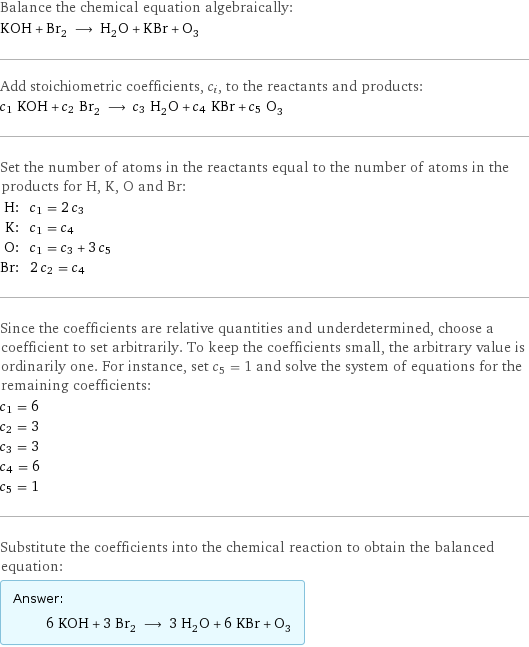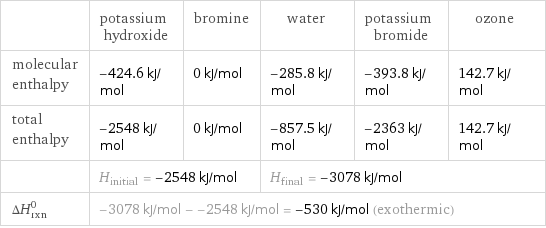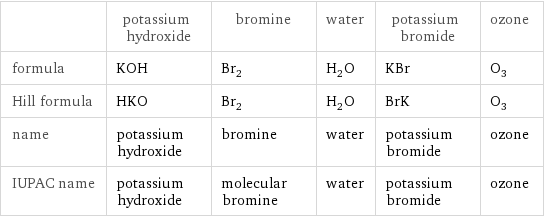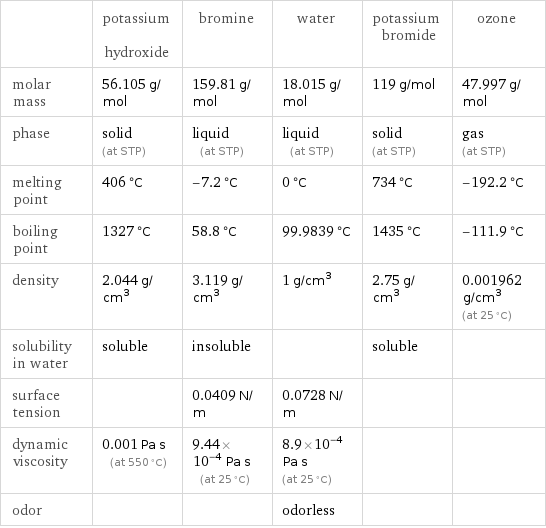Input interpretation

KOH potassium hydroxide + Br_2 bromine ⟶ H_2O water + KBr potassium bromide + O_3 ozone
Balanced equation

Balance the chemical equation algebraically: KOH + Br_2 ⟶ H_2O + KBr + O_3 Add stoichiometric coefficients, c_i, to the reactants and products: c_1 KOH + c_2 Br_2 ⟶ c_3 H_2O + c_4 KBr + c_5 O_3 Set the number of atoms in the reactants equal to the number of atoms in the products for H, K, O and Br: H: | c_1 = 2 c_3 K: | c_1 = c_4 O: | c_1 = c_3 + 3 c_5 Br: | 2 c_2 = c_4 Since the coefficients are relative quantities and underdetermined, choose a coefficient to set arbitrarily. To keep the coefficients small, the arbitrary value is ordinarily one. For instance, set c_5 = 1 and solve the system of equations for the remaining coefficients: c_1 = 6 c_2 = 3 c_3 = 3 c_4 = 6 c_5 = 1 Substitute the coefficients into the chemical reaction to obtain the balanced equation: Answer: | | 6 KOH + 3 Br_2 ⟶ 3 H_2O + 6 KBr + O_3
Structures

+ ⟶ + +
Names

potassium hydroxide + bromine ⟶ water + potassium bromide + ozone
Reaction thermodynamics
Enthalpy

| potassium hydroxide | bromine | water | potassium bromide | ozone molecular enthalpy | -424.6 kJ/mol | 0 kJ/mol | -285.8 kJ/mol | -393.8 kJ/mol | 142.7 kJ/mol total enthalpy | -2548 kJ/mol | 0 kJ/mol | -857.5 kJ/mol | -2363 kJ/mol | 142.7 kJ/mol | H_initial = -2548 kJ/mol | | H_final = -3078 kJ/mol | | ΔH_rxn^0 | -3078 kJ/mol - -2548 kJ/mol = -530 kJ/mol (exothermic) | | | |
Gibbs free energy

| potassium hydroxide | bromine | water | potassium bromide | ozone molecular free energy | -379.4 kJ/mol | 0 kJ/mol | -237.1 kJ/mol | -380.7 kJ/mol | 163.2 kJ/mol total free energy | -2276 kJ/mol | 0 kJ/mol | -711.3 kJ/mol | -2284 kJ/mol | 163.2 kJ/mol | G_initial = -2276 kJ/mol | | G_final = -2832 kJ/mol | | ΔG_rxn^0 | -2832 kJ/mol - -2276 kJ/mol = -555.9 kJ/mol (exergonic) | | | |
Equilibrium constant
![Construct the equilibrium constant, K, expression for: KOH + Br_2 ⟶ H_2O + KBr + O_3 Plan: • Balance the chemical equation. • Determine the stoichiometric numbers. • Assemble the activity expression for each chemical species. • Use the activity expressions to build the equilibrium constant expression. Write the balanced chemical equation: 6 KOH + 3 Br_2 ⟶ 3 H_2O + 6 KBr + O_3 Assign stoichiometric numbers, ν_i, using the stoichiometric coefficients, c_i, from the balanced chemical equation in the following manner: ν_i = -c_i for reactants and ν_i = c_i for products: chemical species | c_i | ν_i KOH | 6 | -6 Br_2 | 3 | -3 H_2O | 3 | 3 KBr | 6 | 6 O_3 | 1 | 1 Assemble the activity expressions accounting for the state of matter and ν_i: chemical species | c_i | ν_i | activity expression KOH | 6 | -6 | ([KOH])^(-6) Br_2 | 3 | -3 | ([Br2])^(-3) H_2O | 3 | 3 | ([H2O])^3 KBr | 6 | 6 | ([KBr])^6 O_3 | 1 | 1 | [O3] The equilibrium constant symbol in the concentration basis is: K_c Mulitply the activity expressions to arrive at the K_c expression: Answer: | | K_c = ([KOH])^(-6) ([Br2])^(-3) ([H2O])^3 ([KBr])^6 [O3] = (([H2O])^3 ([KBr])^6 [O3])/(([KOH])^6 ([Br2])^3)](../image_source/515e7c48d3f6a880eb2fcd7263e02a67.png)
Construct the equilibrium constant, K, expression for: KOH + Br_2 ⟶ H_2O + KBr + O_3 Plan: • Balance the chemical equation. • Determine the stoichiometric numbers. • Assemble the activity expression for each chemical species. • Use the activity expressions to build the equilibrium constant expression. Write the balanced chemical equation: 6 KOH + 3 Br_2 ⟶ 3 H_2O + 6 KBr + O_3 Assign stoichiometric numbers, ν_i, using the stoichiometric coefficients, c_i, from the balanced chemical equation in the following manner: ν_i = -c_i for reactants and ν_i = c_i for products: chemical species | c_i | ν_i KOH | 6 | -6 Br_2 | 3 | -3 H_2O | 3 | 3 KBr | 6 | 6 O_3 | 1 | 1 Assemble the activity expressions accounting for the state of matter and ν_i: chemical species | c_i | ν_i | activity expression KOH | 6 | -6 | ([KOH])^(-6) Br_2 | 3 | -3 | ([Br2])^(-3) H_2O | 3 | 3 | ([H2O])^3 KBr | 6 | 6 | ([KBr])^6 O_3 | 1 | 1 | [O3] The equilibrium constant symbol in the concentration basis is: K_c Mulitply the activity expressions to arrive at the K_c expression: Answer: | | K_c = ([KOH])^(-6) ([Br2])^(-3) ([H2O])^3 ([KBr])^6 [O3] = (([H2O])^3 ([KBr])^6 [O3])/(([KOH])^6 ([Br2])^3)
Rate of reaction
![Construct the rate of reaction expression for: KOH + Br_2 ⟶ H_2O + KBr + O_3 Plan: • Balance the chemical equation. • Determine the stoichiometric numbers. • Assemble the rate term for each chemical species. • Write the rate of reaction expression. Write the balanced chemical equation: 6 KOH + 3 Br_2 ⟶ 3 H_2O + 6 KBr + O_3 Assign stoichiometric numbers, ν_i, using the stoichiometric coefficients, c_i, from the balanced chemical equation in the following manner: ν_i = -c_i for reactants and ν_i = c_i for products: chemical species | c_i | ν_i KOH | 6 | -6 Br_2 | 3 | -3 H_2O | 3 | 3 KBr | 6 | 6 O_3 | 1 | 1 The rate term for each chemical species, B_i, is 1/ν_i(Δ[B_i])/(Δt) where [B_i] is the amount concentration and t is time: chemical species | c_i | ν_i | rate term KOH | 6 | -6 | -1/6 (Δ[KOH])/(Δt) Br_2 | 3 | -3 | -1/3 (Δ[Br2])/(Δt) H_2O | 3 | 3 | 1/3 (Δ[H2O])/(Δt) KBr | 6 | 6 | 1/6 (Δ[KBr])/(Δt) O_3 | 1 | 1 | (Δ[O3])/(Δt) (for infinitesimal rate of change, replace Δ with d) Set the rate terms equal to each other to arrive at the rate expression: Answer: | | rate = -1/6 (Δ[KOH])/(Δt) = -1/3 (Δ[Br2])/(Δt) = 1/3 (Δ[H2O])/(Δt) = 1/6 (Δ[KBr])/(Δt) = (Δ[O3])/(Δt) (assuming constant volume and no accumulation of intermediates or side products)](../image_source/10827daf70df3645f93306b694eda3d0.png)
Construct the rate of reaction expression for: KOH + Br_2 ⟶ H_2O + KBr + O_3 Plan: • Balance the chemical equation. • Determine the stoichiometric numbers. • Assemble the rate term for each chemical species. • Write the rate of reaction expression. Write the balanced chemical equation: 6 KOH + 3 Br_2 ⟶ 3 H_2O + 6 KBr + O_3 Assign stoichiometric numbers, ν_i, using the stoichiometric coefficients, c_i, from the balanced chemical equation in the following manner: ν_i = -c_i for reactants and ν_i = c_i for products: chemical species | c_i | ν_i KOH | 6 | -6 Br_2 | 3 | -3 H_2O | 3 | 3 KBr | 6 | 6 O_3 | 1 | 1 The rate term for each chemical species, B_i, is 1/ν_i(Δ[B_i])/(Δt) where [B_i] is the amount concentration and t is time: chemical species | c_i | ν_i | rate term KOH | 6 | -6 | -1/6 (Δ[KOH])/(Δt) Br_2 | 3 | -3 | -1/3 (Δ[Br2])/(Δt) H_2O | 3 | 3 | 1/3 (Δ[H2O])/(Δt) KBr | 6 | 6 | 1/6 (Δ[KBr])/(Δt) O_3 | 1 | 1 | (Δ[O3])/(Δt) (for infinitesimal rate of change, replace Δ with d) Set the rate terms equal to each other to arrive at the rate expression: Answer: | | rate = -1/6 (Δ[KOH])/(Δt) = -1/3 (Δ[Br2])/(Δt) = 1/3 (Δ[H2O])/(Δt) = 1/6 (Δ[KBr])/(Δt) = (Δ[O3])/(Δt) (assuming constant volume and no accumulation of intermediates or side products)
Chemical names and formulas

| potassium hydroxide | bromine | water | potassium bromide | ozone formula | KOH | Br_2 | H_2O | KBr | O_3 Hill formula | HKO | Br_2 | H_2O | BrK | O_3 name | potassium hydroxide | bromine | water | potassium bromide | ozone IUPAC name | potassium hydroxide | molecular bromine | water | potassium bromide | ozone
Substance properties

| potassium hydroxide | bromine | water | potassium bromide | ozone molar mass | 56.105 g/mol | 159.81 g/mol | 18.015 g/mol | 119 g/mol | 47.997 g/mol phase | solid (at STP) | liquid (at STP) | liquid (at STP) | solid (at STP) | gas (at STP) melting point | 406 °C | -7.2 °C | 0 °C | 734 °C | -192.2 °C boiling point | 1327 °C | 58.8 °C | 99.9839 °C | 1435 °C | -111.9 °C density | 2.044 g/cm^3 | 3.119 g/cm^3 | 1 g/cm^3 | 2.75 g/cm^3 | 0.001962 g/cm^3 (at 25 °C) solubility in water | soluble | insoluble | | soluble | surface tension | | 0.0409 N/m | 0.0728 N/m | | dynamic viscosity | 0.001 Pa s (at 550 °C) | 9.44×10^-4 Pa s (at 25 °C) | 8.9×10^-4 Pa s (at 25 °C) | | odor | | | odorless | |
Units
